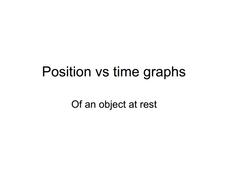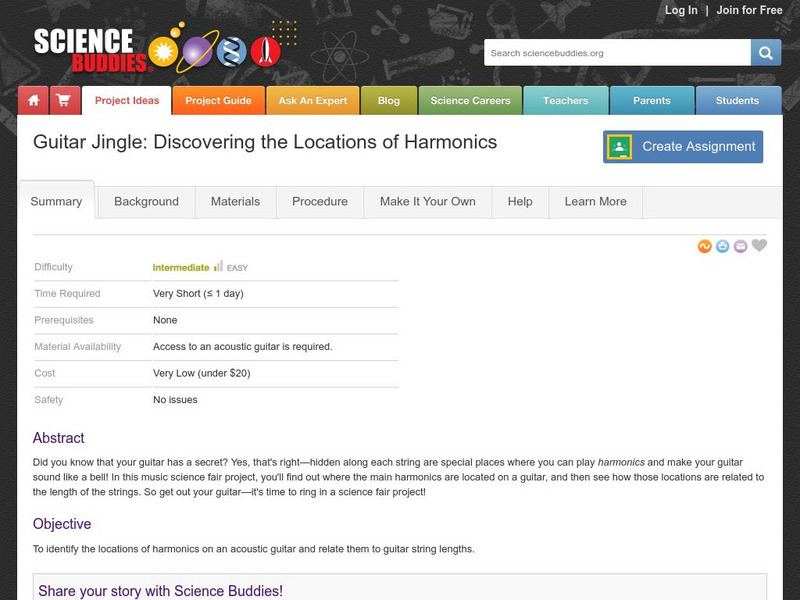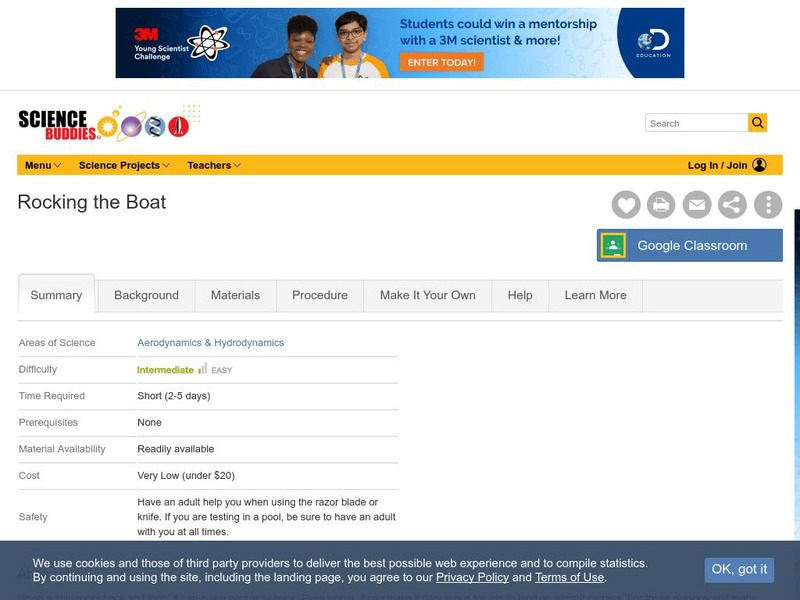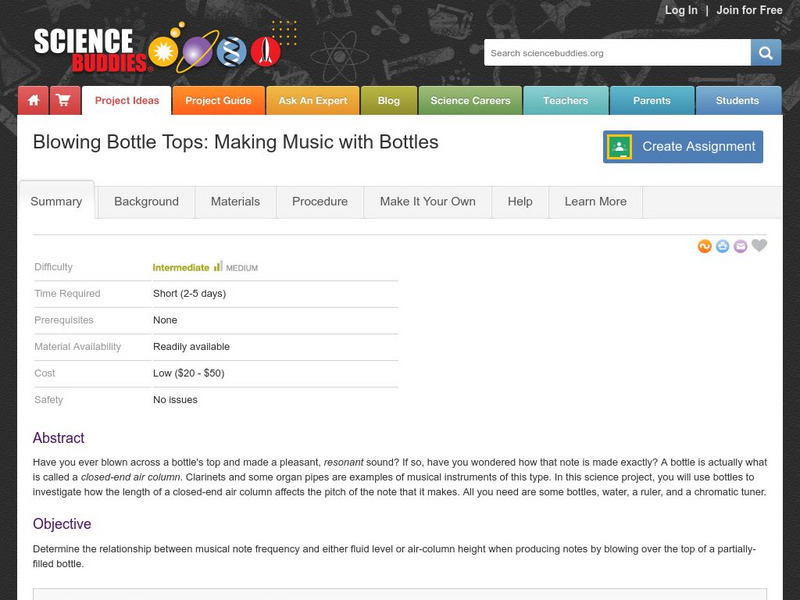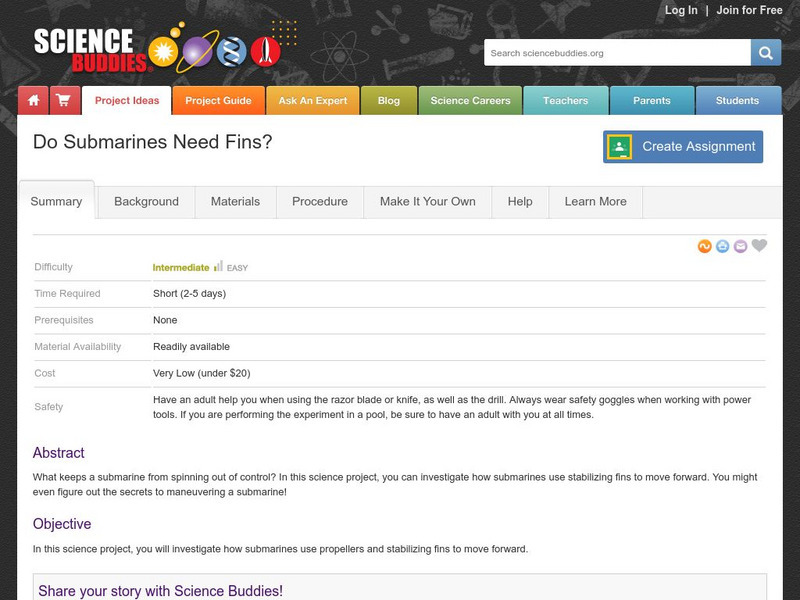Curated OER
Position vs. Time Graphs of an Object at Rest
The presentation includes nine time vs. position graphs. The first three are meant to be used for teaching how to read them. The next three provide an opportunity for students to practice reading them, while the last three display the...
Curated OER
Build Your Own Hovercraft
Students construct a hovercraft following specific procedures. In this technology activity, students explain the physics principles behind hovercraft. They compare and contrast this machine with the aircraft.
Curated OER
Physics and Me
Sixth graders compare and contrast mass and weight. For this physics lesson, 6th graders calculate speed given distance and time information. They construct a rocket and relate this to Newton's 3rd Law of motion.
Curated OER
Rock-A-Bye Pendulum
Third graders analyze the effects of force on an object in motion and its relationship to a change in speed. This lesson uses a pendulum to demonstrate the principle.
Curated OER
Trajectory and Range of a Projectile
Young scholars investigate the factors affecting projectile trajectory. In this physics lesson, students calculate the range, time and speed of projectiles using mathematical equations.
Curated OER
Gel Electrophoresis
Students conduct a variety of experiments to explore gel electrophoresis. In this biology instructional activity, explain how this process separate DNA and RNA. They discuss the practical applications of this method.
Curated OER
Polymerase Chain Reaction (PCR)
High schoolers explore how PCR works through various activities. In this biology lesson, students explain how PCR generate copies of DNA. They simulate the process using an online interactive website.
Curated OER
Graham's Laws: Diffusion and Effusion of Gases
Students conduct a series of experiments to explore Graham's law. In this chemistry lesson, students differentiate effusion and diffusion. They perform calculations using Boyle's, Henry's, Charles' and Graham's Laws.
Curated OER
Rock-A-Bye Pendulum
Third graders use the scientific process to explore the effects of force on an object in motion. They demonstrate that the greater the force applied to an object, the greater the change in speed or direction of the object. They...
Curated OER
Incandescent Light Bulb
Young scholars study the history of the light bulb and how an incandescent light bulb works. In this electricity lesson students complete several experiments on the light bulb.
Curated OER
Airplane Propeller
Students examine the different kinds of propellers and their functions. In this airplane lesson students build a hand made propeller.
Curated OER
Electroscope
Students examine what an electroscope is and who invented it. In this electrical instructional activity students build their own Emergency Radiation detector Electroscope.
Curated OER
Balloons
Young scholars explore the different types of balloons. In this materials lesson students can complete several experiments including building their own hot air balloons, making balloon animals and experimenting with static...
Curated OER
Investigation 4 - Collision Zone
Third graders study how forces of push and pull can change speed or direction.
Science Buddies
Science Buddies: Project Ideas: Paintball Ballistics
In this science fair project, use a paintball gun to compare the calculated vs. the actual range of a projectile. The Science Buddies project ideas are set up consistently beginning with an abstract, objective, and introduction, followed...
Science Buddies
Science Buddies: Drag Racing in the Water
It's fun to go swimming. To feel the power of your body as you launch yourself into the water. But did you know that swimming isn't just about skill and athleticism? The human body consists of skin, contours, and curves. How the water...
Science Buddies
Science Buddies: The Unconstrained Truth About Constrained Layer Damping
This science fair project shows you how to transform a noisy piece of metal into a sound-muffling constrained-layer damper. You will record the sound of a controlled impact on a piece of metal with a microphone, a computer, and some free...
Science Buddies
Science Buddies: Guitar Jingle: Discovering the Locations of Harmonics
In this music science fair project, students will discover the locations of harmonics on an acoustic guitar and relate them to guitar string lengths.
Science Buddies
Science Buddies: Rocking the Boat
Become an engineer for a day and discover the best way to keep from rocking the boat in this engineering science fair project. When a ship rocks back and forth, it can make people seasick, but also it makes it dangerous for jets to land...
Science Buddies
Science Buddies: Focusing Your Flash for 'Freezing' Motion
Here's an interesting flash photography project. With an inexpensive Fresnel lens, you can concentrate the light from your flash. You'll be able to shoot with a smaller aperture and a shorter flash duration. This will give you a greater...
Science Buddies
Science Buddies: Swing Low: Investigate the Motion of a Pendulum
Kids love to ride the swings at the playground. The back-and-forth motion of a swing demonstrates the physics of a pendulum. In this experiment, you will investigate the factors that affect the speed and duration of a pendulum's swing.
Science Buddies
Science Buddies: Blowing Bottletops: Making Music With Glass Bottles
This is a musical project about the resonance of closed-end air columns. Organ pipes, flutes, and brass instruments are examples of musical instruments of this type. In this project, you'll learn how the pitch of the note produced...
Science Buddies
Science Buddies: Singing Wine Glasses
Making a glass sing is not always as easy as it looks. This project explains the science behind the interesting hobby. You will be asked how the amount of fluid within a glass affects its pitch.
Science Buddies
Science Buddies: Do Submarines Need Fins?
In this science project, you can investigate how submarines use stabilizing fins to move forward. Exploring friction and buoyant force you will get closer to understanding how these large ships function. Research resources are included...


